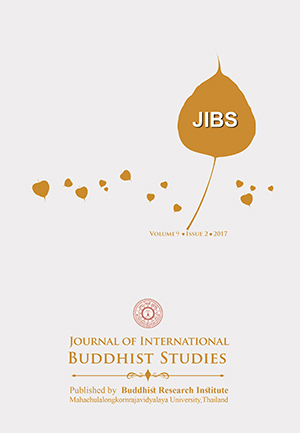The Contemporary Thai Version of the Kathin Ceremony: Ceremonial Importance of the Distribution of White Envelops and the Money Tree Tradition
Keywords:
Kathin, Contemporary Thai Society, Kamma, DānāAbstract
The Kathin ceremony is generally known as a ceremony of the Buddhist laypeople to make an offering of new robes to the monks. The joyfulness of people in the contemporary Thai Kathin festival reflects a fusion of the traditional ritual and the modern socioeconomic context in the Thai society, which can be explained in three points. Firstly, since there is a strong incorporation between Animism, Buddhism and Brahmanism-Hinduism. Kathina reflects a combination of all the three beliefs, conducting good deeds to some sacred things in exchange of the protection from them as in the Animism theme, giving new robes to the monk as the traditional Buddhist scripture allows them to conduct, and putting a great deal of effort to create richness of rituals and processes as the Brahmanism-Hinduism heritage. Secondly, capitalism has trained people heavily on investing for gaining something. Apparently, there are many laypeople who conduct meritorious practices for gaining some instant happiness. Since Kathina is a ceremony recognized to provide a great amount of good result manifestation regarding the Law of Kamma, it is therefore not unusual to find the Thai laypeople who are enjoying enclosing some banknotes into the white envelopes or to attach some banknotes on to the money tree. However, the Law of Kamma is complex. Sometime, it seems a person will spend more than a lifetime to see the results of what one sowed. Being generous or gaining merit acquired by giving, therefore, seems to becomes something to heal people from the everyday traumas of life. In other words, giving is a way to help them emotionally not a way to purify their mind.
References
Bodhi, B. (Ed.). (1995). The Middle Length Discourses of the Buddha: A New Translation of the Majjhima Nikāya. (B. Ñāṇamoli, Trans.) Kandy, Sri Lanka: Buddhist Publication Society. Retrieved June 23, 2018, from https://ia800208.us.archive.org/25/items/Majjhi maNikaya/Majjhima%20Nikaya_text.pdf
Boonbongkarn, S. (n.d.). Wat Phra Ram 9. Retrieved June 29, 2018, from The Chipattana Foundation: http://www.chaipat.or.th/publication/ publish-document/tips/43-2009-12-21-02-36-00.html
Buddhaghosacariya, S. P. (2017). Buddhadhamma: The Laws of Nature and Their Beneifts to Life. (R. P. Moore, Trans.) Bangkok: Buddhadhamma Foundation.
Cassaniti, J. (2015). Living Buddhism: Mind Self, and Emotion in a Thai Community. London: Cornell University Press.
Desai, S. N. (1980). Hinduism in Thailife. Bombay: Popular Prakashan Private LTD.
Kanlayanadhammo, P. (2017, March 9). The Pattern of Offering Dana Helping one ot the Enlightenment of the Dhammas in Present Thai Societies. Journal of MCU Peace Studies 5(2):133-143. Retrieved June 26, 2018, from : https://www.tci-thaijo.org/ index.php/journal-peace/article/view/79527
Maliwan, P. (1984). Buddhist Religion for People Volume I. Bangkok: Kansatsana Printing House.
Mcdamiel, J. T. (2011). The Lovelorn Ghost & The Magical Monk. New York: Columbia University Press.
Office of Prime Minister of Thailand (2017). The Twelfth National Economic and Socail Development Plan 2017-2021. Bangkok, Thailand. Retrieved 2018, from http://www.nesdb.go.th: http://www.nesdb. go.th/nesdb_en/ewt_dl_link.php?nid=4345
Mulder, N. (2000). Inside Thai Society: relision Everyday Life Change. Bangkok: Silkworm Books.
Müller, F. (1881). The Sacred Books Of The East . Volume XIII. (v. o. scholars, Trans.) Delhi, India: Shantilal Jain, Shri Jainendra Press. Retrieved June 5, 2018, from https://ia801905.us.archive.org/16/ items/in.ernet.dli.2015.69022/2015.69022.The-Sacred-Books-Of- The-Eastvol13_text.pdf
Müller, F. (1965). The Sacred Books Of The East. XVII. Delhi, India: Shantilal Jain, Shri Jainendra Press. Retrieved June 5, 2018, from https://ia801604.us.archive.org/30/items/in.ernet. dli.2015.264633/2015.264633.The-Sacred_text.pdf
Payutto P.A. (2005, January 4). Dictionary of Buddhism. Retrieved 05 19, 2018, from DhammaThai: http://www.84000.org/tipitaka/dic
Scott, R. M. (2009). Nirvana for Sale?: Buddhism, Whealth, and the Dhammakāya Temple in Contemporary Thailand. New york: Suny Press.
Taylor, J. (1999). (Post-) Modernity, remaking tadition and the hybridisation of Thai Buddhism. Anthropological Forum, Vol. 9, No. 2, 163-187. Terwiel, B. J. (2012). Monks and Magic: Revisiting a Classic Study of
Religious Cermonies in Thailand. Thailand: Nias Press. Thairathonline. (2013, November 4). Retrieved June 24, 2018, from
Thairath: https://www.thairath.co.th/content/380458
The Book of The Gradual Sayings (Anguttara-Nikaya) Vol.IV. (1935). VI. (E.M.HARE, Trans.) London, Great Britain: The Oxford University Press. Retrieved June 23, 2018, from https://ia801609.us.archive. org/14/items/in.ernet.dli.2015.283032/2015.283032.The-Book_text.pdf







